Disclosure: We may earn commissions if you purchase products after clicking on a link from our site.
Are you interested in fishing for mutton snapper? Do you want to learn how to catch mutton snapper? They are found from New England to South America. However, they are mostly concentrated in South Florida and parts of the Caribbean. Mutton snappers are very wary and can be challenging to fool with lures.
In this article, we share information on how to catch mutton snapper, the best tips and tricks to successfully catch them, as well as the tackle, bait, and lures to use.
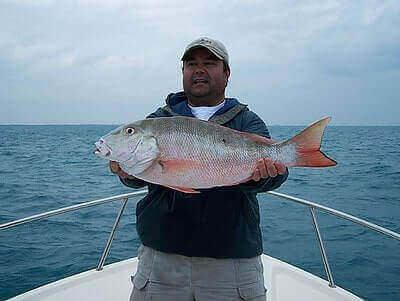
Table of Contents
How To Catch Mutton Snapper
1. Drift Fishing
Drift fishing is a versatile and effective method for targeting mutton snapper in a variety of environments, including reefs, wrecks, and offshore structures. This technique involves allowing the boat to drift naturally with the current while presenting baits or lures to mutton snapper as they forage along the bottom or within the water column.
Anglers typically use a combination of live or cut bait such as squid, shrimp, or small fish rigged on appropriate hooks and weights to keep them near the desired depth. By drifting over productive areas, anglers can cover a wide range of territory and increase their chances of encountering feeding mutton snapper.
It’s essential to monitor the drift speed and direction to ensure baits or lures remain in the strike zone and adjust as necessary to stay in productive spots. Additionally, using a fish finder or depth sounder can help locate underwater structures where mutton snapper are likely to congregate during the drift.
2. Baitcasting
Baitcasting is a popular fishing method for targeting mutton snapper, offering anglers precision and control when presenting baits in areas where these prized fish are abundant. To catch mutton snapper using baitcasting gear, anglers typically utilize medium to heavy-action rods paired with low-profile baitcasting reels spooled with braided or monofilament fishing lines.
The key to successful baitcasting for mutton snapper lies in selecting the right bait and presenting it effectively. Anglers often use live or cut bait such as squid, shrimp, or small fish rigged on appropriate hooks and weights to keep them near the desired depth.
When casting, anglers should aim to place their bait near underwater structures where mutton snappers are known to congregate, such as reefs, wrecks, or rocky outcroppings. Proper technique, including thumb control to manage spool speed and prevent backlash, is crucial to ensure accurate casts and minimize tangles.
Patience is also essential, as mutton snappers can be wary and selective feeders. By mastering the art of baitcasting and understanding the behavior of mutton snapper, anglers can increase their chances of success in landing these prized fish.
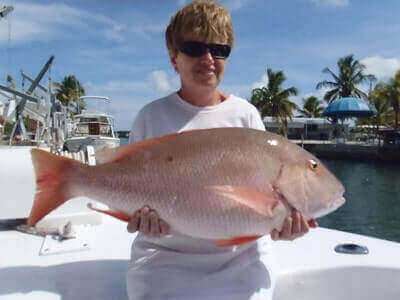
3. Bottom Fishing
Bottom fishing is one of the most popular methods for catching mutton snapper. Anglers typically use bait such as squid, shrimp, or cut fish, which is presented on or near the ocean floor where mutton snapper are known to inhabit.
This technique involves anchoring or drifting over reef structures, wrecks, or ledges where mutton snapper are commonly found. Once the bait is lowered to the bottom, anglers wait for the distinctive bite of the mutton snapper. It’s crucial to use the right tackle and rigging for bottom fishing to ensure the bait stays in the strike zone and withstands the potential abrasion from the structure.
Regulations regarding bottom fishing for mutton snapper may vary by location, so anglers should consult resources provided by government fisheries departments like NOAA Fisheries for specific guidelines and regulations.
4. Chumming
Chumming is a technique used to attract mutton snapper to the vicinity of the boat by dispersing small particles of baitfish or scent into the water. Anglers typically use a combination of ground-up baitfish, fish oil, and other attractants to create a chum slick that drifts with the current and draws mutton snapper closer.
Once the fish are concentrated around the boat, anglers can present baits or lures to entice strikes. Chumming can be particularly effective when fishing over reefs, wrecks, or other structures where mutton snapper congregate. However, anglers should be mindful of local regulations regarding chumming, as excessive use can have negative impacts on the marine environment.
5. Night Fishing
Night fishing for mutton snapper can be a rewarding strategy, as these fish are often more active during the cover of darkness, venturing out from their daytime hiding spots to feed under the veil of darkness. Anglers targeting mutton snapper at night typically use a variety of techniques and equipment tailored to low-light conditions.
This may include specialized lights to attract baitfish and illuminate the water, as well as electronic fish finders to locate promising underwater structures such as reefs and ledges where mutton snapper tend to congregate. Anglers often employ live or cut bait such as squid, shrimp, or small fish, presented on rigs designed to keep the bait near the bottom where mutton snapper feed.
Patience and stealth are essential during night fishing excursions, as mutton snapper can be sensitive to disturbances in the water. Anglers should also take precautions to ensure safety while navigating and fishing in darkness, including the use of navigational lights and proper anchoring or mooring techniques. By employing effective strategies and adapting to the unique challenges of fishing at night, anglers can increase their chances of success in targeting mutton snapper during nocturnal hours.
6. Trolling
Trolling is an effective method for covering a large area of water and locating schools of mutton snapper, particularly in offshore or open-water environments. Anglers typically use artificial lures or rigged baits such as squid or strip baits, which are trailed behind a moving boat at various speeds.
Downriggers or planers may be employed to help get the baits to the desired depth where mutton snapper are holding. Trolling allows anglers to explore different depths and areas until they locate active fish. Once a school of mutton snapper is located, anglers can slow down or stop the boat to focus on that specific area. Anglers should be aware of any regulations regarding trolling for mutton snapper and practice responsible fishing practices.
7. Fly Fishing
While less common than other methods, fly fishing for mutton snapper can be a rewarding and challenging pursuit for anglers. Anglers typically use saltwater fly rods and reels loaded with sinking or intermediate fly lines and weighted flies that mimic baitfish or crustaceans.
Sight fishing over shallow reefs or flats is often the preferred approach, although blind casting around structures or drop-offs can also yield results. Presentation and accuracy are critical when fly fishing for mutton snapper, as these fish can be wary and easily spooked in clear water. Anglers should consult government fisheries resources for any regulations specific to fly fishing for mutton snapper in their area.
8. Vertical Jigging
Vertical jigging is a dynamic and exciting technique for catching mutton snapper, especially in deeper water or around structures such as wrecks or reefs. Anglers use heavy metal jigs designed to mimic the movement of baitfish or squid, which are dropped vertically and jigged up and down through the water column.
Mutton snappers are known to respond well to the erratic action of jigs, often striking on the descent or during a pause in the retrieve. It’s essential to vary the speed and cadence of jigging to determine what triggers the most bites. Anglers should also be prepared for powerful strikes and ensure they have the appropriate tackle to handle the larger specimens.
As with other fishing methods, anglers should familiarize themselves with any regulations governing the use of vertical jigs for mutton snapper fishing.
9. Live Bait Fishing
Live bait fishing can be highly effective for targeting mutton snapper, especially when targeting larger specimens. Anglers typically use live baitfish such as pilchards, pinfish, or grunts, which are rigged on a hook and presented near the bottom or suspended at various depths using a float or downrigger.
The natural movement and scent of live bait can entice mutton snapper to strike, particularly during low-light conditions or when the fish are actively feeding. Anglers should handle live baitfish carefully to keep them lively and attractive to mutton snapper. Additionally, regulations regarding the use of live bait for mutton snapper fishing may exist, so anglers should consult government fisheries resources for guidance.
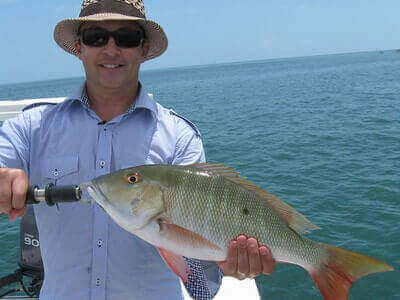
Mutton Snapper Fishing Tackle
A medium-weight saltwater conventional rod with a 15-20 lb test line will work. If you are fishing fishing in nearshore estuaries then light tackle will work.
Best Baits For Mutton Snapper
1. Pinfish
Pinfish serve as excellent bait when targeting mutton snapper due to their natural appearance and enticing movement in the water. Anglers can catch pinfish using a variety of methods, including using a cast net or a small hook and line setup baited with shrimp or squid near structures such as docks, piers, or rocky areas where pinfish tend to congregate.
Once caught, anglers can rig the pinfish onto a hook using a standard bottom fishing rig or a fish finder rig, allowing the bait to swim freely and attractively in the water column where mutton snappers are known to feed. Pinfish are particularly effective bait for mutton snapper due to their ability to remain active and lively on the hook, mimicking the behavior of natural prey and enticing strikes from hungry fish.
Anglers should adjust their hook size and presentation to match the size of the pinfish and the preferences of the mutton snapper in their targeted area. Regulations regarding the use of pinfish as bait may vary by location, so anglers should consult local fishing authorities such as the Florida Fish and Wildlife Conservation Commission for specific guidelines and regulations before using pinfish bait for mutton snapper.
2. Pilchards
Pilchards, also known as scaled sardines, are a popular bait choice for targeting mutton snappers due to their natural scent, oily texture, and attractive swimming action in the water. Anglers can catch pilchards using various methods, including cast nets, sabiki rigs, or small hooks baited with pieces of shrimp or squid.
Pilchards are often found near shallow reefs, grass flats, and structures such as docks or piers, making them relatively easy to catch with the right equipment and techniques. Once caught, anglers can rig pilchards onto a hook using a variety of methods, including threading them onto a hook through the lips or tail, or using a butterfly jigging technique to imitate injured baitfish.
When targeting mutton snappers, anglers should present the pilchard bait near rocky bottoms, ledges, or drop-offs where mutton snappers are known to congregate. Pilchards can be fished using various rigs, including fish finder rigs or knocker rigs, allowing the bait to swim naturally and attractively in the water column.
It’s essential to match the hook size and presentation to the size of the pilchards and the preferences of the mutton snapper in the area. Before using pilchards as bait for mutton snapper, anglers should check local regulations and guidelines, as regulations regarding the use of live bait may vary by location.
3. Ballyhoo
Ballyhoo, a popular baitfish species among anglers, is an excellent choice for targeting mutton snapper due to its lifelike swimming action and appealing scent. Anglers can catch ballyhoo using various methods such as cast nets, sabiki rigs, or trolling with small lures designed to mimic baitfish.
Ballyhoo are often found near reefs, wrecks, and offshore structures, making them accessible to anglers fishing in coastal and offshore waters. Once caught, anglers can rig ballyhoo onto a hook using a variety of techniques, including nose hooking, bridling, or rigging them with wire or monofilament to enhance their swimming action.
When targeting mutton snappers, anglers should present the ballyhoo bait near rocky bottoms, ledges, or drop-offs where mutton snappers are known to feed. Various rigging options, such as fish finder rigs or knocker rigs, can be used to allow the ballyhoo to swim naturally and entice the mutton snapper to strike.
Before using ballyhoo as bait for mutton snapper, anglers should ensure compliance with local fishing regulations and guidelines, as rules regarding baitfish use may vary by location. Anglers should refer to authoritative sources such as the National Oceanic and Atmospheric Administration (NOAA) Fisheries website for specific regulations and conservation measures related to baitfish harvesting and usage in their area.
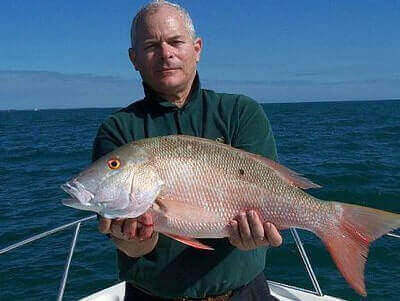
4. Mullet
Mullet serves as a highly effective bait for targeting mutton snapper, renowned for their large size and robust fighting ability. Anglers can procure mullets using various methods, including cast nets, seine nets, or even hook-and-line techniques. These baitfish are commonly found in coastal areas, estuaries, and nearshore waters, making them accessible to anglers fishing from boats, piers, or shorelines.
Once caught, mullet can be rigged onto fishing hooks using a range of techniques, such as through the lips, behind the dorsal fin, or tail-hooked to allow for natural movement in the water. When targeting mutton snappers, anglers should present the mullet bait near reef structures, ledges, or underwater formations where mutton snappers tend to congregate.
Rigging options such as fish finder rigs or knocker rigs are ideal for presenting mullet bait effectively and enticing strikes from mutton snapper. Anglers need to verify and comply with local fishing regulations concerning the use of mullet as bait and any restrictions on harvesting or possession.
5. Shrimp
Shrimp are a versatile and widely used bait for targeting mutton snapper, prized for their scent and attractiveness to various saltwater species. Anglers can obtain shrimp from bait shops, and seafood markets, or catch them using cast nets in shallow coastal waters, estuaries, or tidal creeks.
When fishing for mutton snapper, anglers typically rig live or fresh-dead shrimp onto fishing hooks using methods such as Carolina rigs, knocker rigs, or dropper loop rigs. These rigs allow the shrimp to move naturally in the water, mimicking live prey and increasing their effectiveness in enticing strikes from mutton snapper.
Anglers should present the shrimp bait near reef structures, ledges, or other underwater features where mutton snappers are known to inhabit. Patience and strategic casting around these areas can increase the chances of success when targeting this species. Anglers need to adhere to local fishing regulations regarding the use of shrimp as bait and any size or possession limits for mutton snapper.
6. Goggle Eyes
Google Eyes, also known as goggle-eyes or bigeye scad, serve as effective bait for targeting mutton snappers, especially in offshore and deep-sea fishing scenarios. These baitfish are prized for their large, reflective eyes, which can attract predatory species like mutton snapper from a distance.
Anglers can catch Google Eyes using live baitfish traps or by casting small jigs or sabiki rigs around bait schools or structure-rich areas offshore. When targeting mutton snapper, anglers typically rig live Google Eyes on circle hooks or J-hooks using a variety of methods such as knocker rigs, Carolina rigs, or live bait rigs.
The presentation of live Google Eyes near reef structures, wrecks, or ledges where mutton snapper congregate can entice strikes from these prized gamefish. Anglers should ensure that their gear is properly sized and matched to the size of the Google Eyes being used as bait, as mutton snapper can be wary of oversized or unnatural presentations.
Anglers need to adhere to local fishing regulations regarding the use of Google Eyes as bait and any size or possession limits for mutton snapper. For authoritative information on fishing regulations and conservation measures related to baitfish use in a specific area, anglers should consult official sources such as the National Oceanic and Atmospheric Administration (NOAA) Fisheries website.
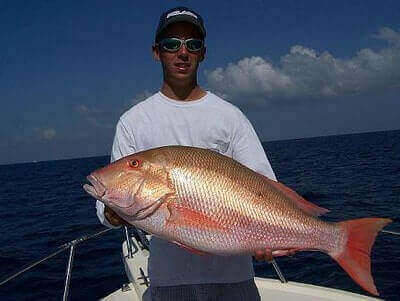
Best Lures For Mutton Snapper
1. Jigs
Jigs are versatile lures that can be highly effective for catching mutton snapper in various fishing environments, including reefs, wrecks, and offshore structures. These artificial baits mimic the movement of baitfish or other prey, enticing mutton snapper to strike.
Anglers can employ different jigging techniques such as vertical jigging, pitch jigging, or slow-pitch jigging to entice mutton snapper to bite. When using jigs to target mutton snappers, anglers should select colors and sizes that closely resemble the local forage species, such as small baitfish or squid.
It’s essential to vary the jigging action to find the most effective presentation, as mutton snappers may prefer different speeds and movements depending on factors like water depth and current strength. Additionally, anglers should use high-quality tackle, including stout rods and reels with smooth drags, to handle the powerful strikes and vigorous fights characteristic of mutton snapper.
Before heading out, anglers should consult local fishing regulations and marine conservation guidelines to ensure compliance with size and possession limits for mutton snapper and to promote sustainable fishing practices.
2. Swimbaits
Swimbaits are effective lures for targeting mutton snapper, offering a lifelike swimming action that mimics the movement of natural prey. These soft plastic baits often feature realistic designs and intricate detailing, making them irresistible to predatory fish like mutton snapper. Anglers can rig swimbaits on weighted jig heads or swimbait hooks to achieve the desired depth and action.
When fishing for mutton snapper, it’s essential to select swimbaits in colors and sizes that match the local baitfish species. Anglers can work swimbaits at various speeds and depths, experimenting with different retrieval techniques such as steady retrieves, erratic twitches, or pauses to trigger strikes from mutton snappers.
Swimbaits are versatile lures that can be effective when cast, trolled, or jigged around reefs, wrecks, and other underwater structures where mutton snapper often congregate. To maximize success, anglers should use high-quality tackle and ensure their gear is properly matched to the size and strength of the targeted fish. Before heading out, anglers should familiarize themselves with local fishing regulations and marine conservation guidelines to promote sustainable fishing practices.
For comprehensive information on fishing regulations and conservation measures related to mutton snapper, anglers can refer to official resources such as the website of the National Marine Fisheries Service.
3. Crankbaits
Crankbaits are versatile lures that can be effective for catching mutton snapper in a variety of fishing situations. These hard-bodied lures feature a diving lip that allows them to dive to specific depths, making them ideal for targeting mutton snapper holding near the bottom or around underwater structures such as reefs and wrecks.
Anglers can choose crankbaits in sizes and colors that closely resemble the local baitfish species preferred by mutton snapper. When fishing with crankbaits for mutton snapper, anglers can employ a variety of retrieval techniques, including steady retrieves, erratic jerks, and pauses, to mimic injured or fleeing prey and entice strikes.
It’s essential to use crankbaits with strong, corrosion-resistant hooks and durable construction to handle the powerful strikes and rugged underwater terrain associated with mutton snapper fishing. Anglers can experiment with different crankbait styles, diving depths, and actions to determine what triggers the most bites from mutton snappers in their area.
Before heading out, anglers should consult official resources such as the website of the National Marine Fisheries Service for up-to-date information on fishing regulations and conservation measures about mutton snapper. Additionally, anglers should practice responsible angling practices, including proper handling and release techniques for undersized or non-targeted fish, to help maintain healthy fish populations for future generations.
How To Catch Mutton Snapper In The Florida Keys
The Florida Keys is an angler’s dream destination for fishing. There are many different species of fish in the Florida Keys and mutton snapper is one of them. There are many fishing methods you can use when fishing in the Florida Keys.
1. Baitcasting
Baitcasting is one of the popular and effective ways of catching mutton snapper in the Florida Keys. It is also a good fishing method to learn how to catch mutton snapper. Lures and bait are used when baitcasting for mutton snapper. Speedo, jigs, pinfish, squid, mullet, pilchards, and shrimp are some of the bait and lures you can use.
2. Drift Fishing
You can fish for mutton snapper by drift fishing. When drift fishing, you let your bait drift with the current and when you get a strike, set the hook and reel them in. Drift fishing is very effective and can be used to target mutton snapper at different areas in the ware column.
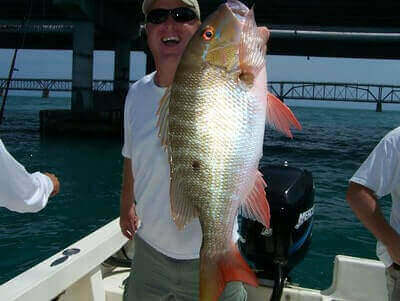
3. Night Fishing
Night fishing can be very productive as most fish feed at night. When fishing for mutton snapper at night, you can use lures or bait to target them.
4. Chumming
Chumming is a fishing technique that attracts fish and brings them closer to the boat. it is very effective and can get the fish into a feeding frenzy. Pieces of bait are dropped into the water to create a chum slick that leads back to the boat. As mutton snappers eat the chum, they are brought closer to the boat where you can drop your bait, hook them, and get them into the boat.
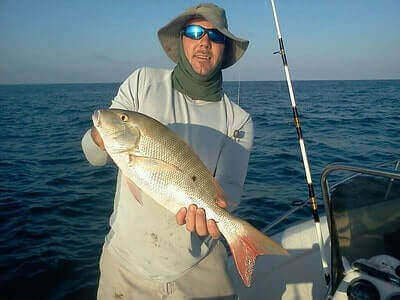
Best Rigs For Mutton Snapper
1. Deep Sliding Sinker Rig
The deep sliding sinker rig works well as a bottom rig when fishing for mutton snapper.
Make a Bimini Twist on the end of the main line.
Thread the double line through the open end of a 150-pound snap swivel.
Fasten the double line to one end of a barrel swivel.
Tie 25 to 30 feet of 30- to 40-pound fluorocarbon to the other end of the barrel swivel.
Attach a 5/0 to 7/0 inline circle hook with a loop knot.
Tie 2 feet of 15-pound mono to the snap and make a loop on the end to hitch an egg sinker.
2. Fish Finder Rig
The fish finder rig works well when fishing for mutton snapper. It is a bottom fishing rig that can be used for inshore and offshore fishing for mutton snapper and a variety of other species of fish.
Slide a 1/2- to 2-ounce egg sinker up the main line and secure a large barrel swivel to the terminal end. If heavier weights are needed to hold the bottom, use a fish-finder snap-swivel slide to attach a bank sinker.
Secure a 30-inch length of 20- to 40-pound-test monofilament leader to the barrel swivel and snell an appropriate-sized hook to the terminal end.
Mutton Snapper Fishing Tips
- When you go mutton snapper fishing, go with a lot of live and dead bait.
2. Pinfish, Speedo, pilchards, ballyhoo, goggle eye, threadfin herring, mullet, and shrimp are some of the best bait for mutton snapper.
3. Mutton snapper has a habit of biting and dropping bait a few times before eating it or not eating it when they are not very aggressive.
4. If a mutton snapper tugs at a bait and detects an unnatural feel with resistance, it will become suspicious and leave the bait.
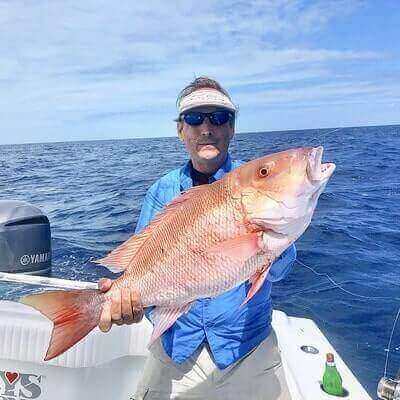
5. When hooked, mutton snapper will give you a hard fight for a good period of time. They will make strong runs toward rocks.
6. Mutton snapper bite well during the night, especially when there is a full moon.
7. Mutton snapper is a delicious fish with firm white meat.

The Bottom Line
Mutton snapper is a favorite of anglers as they are hard fighting, wary, and found in many areas and is a delicious fish. They can be found around structures where they wait to ambush baitfish. There are many fishing methods such as baitcasting, chumming, drift fishing, night fishing, and bottom fishing that can be used to catch mutton snapper.
In this article, we discussed how to catch mutton snapper, shared tips and tricks, as well as discussed the fishing methods often used by anglers when fishing for mutton snapper. You can also read how to catch lane snapper, how to catch mangrove snapper, how to catch yellowtail snapper, how to catch vermillion snapper, how to catch cubera snapper, and how to catch red snapper.